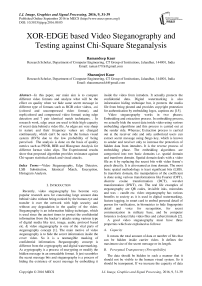XOR-EDGE based Video Steganography and Testing against Chi-Square Steganalysis
Автор: Ramandeep Kaur, Sharanjeet Kaur
Журнал: International Journal of Image, Graphics and Signal Processing(IJIGSP) @ijigsp
Статья в выпуске: 9 vol.8, 2016 года.
Бесплатный доступ
In this paper, our main aim is to compare different video formats and analyze what will be the effect on quality when we hide same secret message in different type of formats such as RGB color videos, .avi (colored and uncompressed video format), and mp4(colored and compressed video format) using edge detection and 7 pair identical match techniques. . In research work, edge areas are used to hide high capacity of secret data behind a video file. As edges are very sharp in nature and their frequency values are changed continuously, which can't be seen by the human visual system (HVS) due to the low probability of being perceived. The analysis is done on the basis of quality metrics such as PSNR, BER and Histogram Analysis for different format video clips. The Experimental results show that proposed algorithm provides resistance against Chi-square statistical attack and visual attacks.
Video Steganography, Edge Detector, LSB Substitution, Identical Match, Encryption, Histogram Analysis
Короткий адрес: https://sciup.org/15014013
IDR: 15014013
Текст научной статьи XOR-EDGE based Video Steganography and Testing against Chi-Square Steganalysis
Published Online September 2016 in MECS
Video steganography works in two phases; Embedding and extraction process. In embedding process, we actually hide the secret data inside video using various embedding algorithms and this process is carried out at the sender side. Whereas; Extraction process is carried out at the receiver side and only authorized users can extract secret message using Stego key, which is known to sender and receiver only to increase the protection of hidden data from intruders. It is the reverse process of embedding phase. The embedding algorithms are categorized into two basic domains i.e. spatial domain and transform domain. Spatial domain deals with a video file as it by replacing the secret bits with video frame’s pixels directly. It is also named as time domain. The most basic spatial methodology is least significant bits (LSB). In transform domain, the manipulation of the coefficient is done using various transformations like Fourier (DFT), discrete cosine transformation (DCT), wavelet transformation (DWT), etc. The real life examples of steganography are QR codes, invisible inks, microdots and wax – candle etc. video steganography has various benefits to society as it is used in digital watermarking, feature tagging, in smart card to embed personal detail of person for verification, in biometrics to hide fingerprints detail and voice for recognition, for secret communication in military base, and by computer forensics to detect fake video files and cybercriminals [2].
A good video steganography must have three properties which are explained as follows:
-
A. Capacity
It means the total amount of data or number of bits that can be hidden inside carrier video. It defines the maximum size of the secret message or its length.
-
B. Perceptual Transparency (Perceptibility)
The data should be hidden in such a manner that it should not be visible to the human visual system. So it should be transparent. If we increase the capacity of data then its transparency will be affected. Perceptual transparency is of two types: Quality and fidelity.
-
C. Security
Attackers can extract the important information by applying various attacks. So security of video steganography must be high using various encryption and security algorithms.
-
D. Cryptography vs. Steganography
Cryptography is the data security technique which is used to encrypt the secret or plain information into unreadable (Cipher) format. It just changes the message readability not imperceptibility like steganography. Cryptography is used only for text files and not used for digital files like audio, image and video files. There are various types of encryption algorithms are available which helps to increase the security of confidential information and protect data from any unauthorized access or cyber criminals such as hackers, attackers etc. Generally, cryptography is divided into two main classes i.e. symmetric key algorithm and Asymmetric key based algorithms:
-
• Symmetric Key Based Cryptography : In
-
• Asymmetric Key Based Cryptography :
Asymmetric key-based encryption algorithms provides high security than symmetric key algorithm as there is no need of third party member to share a secret key between sender and receiver. Both sender and receiver have their own public and private key to encrypt and decrypt the plain text. The basic asymmetric encryption methods are RSA and Diffie-Hellman, Blowfish Algorithms. Both algorithms are highly secure methods and have high time and space complexity.
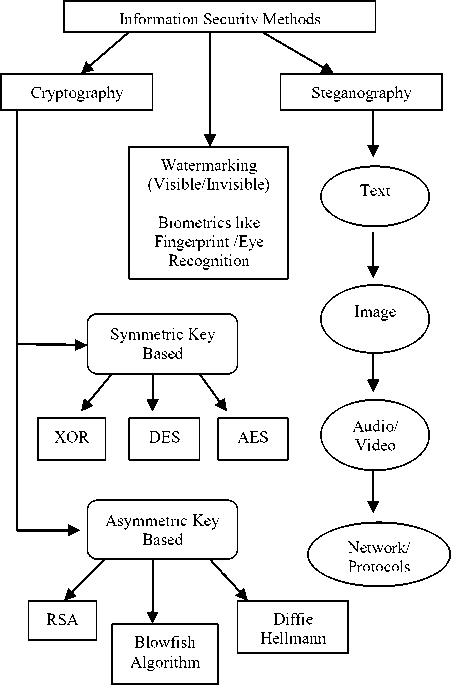
Fig.1. Information Security Methods
This paper explores the concept of steganography by using a hybrid approach for video steganography using edge detection and 7 pair based identical match techniques to enhance the hiding capacity, quality and security. Also, a comparative analysis has been carried out using different video formats to analyze the quality of Stego video and using histogram analysis. The results have been taken out practically by using MATLAB toolbox for simulation.
-
II. Related Work
The main issue of video steganography is to protect the confidential information from the intruders and provide it more security from the attacks. To avoid this problem, many algorithm and steganography mechanisms have been proposed to reduce the effect of attacks on carrier video as well as to maintain its imperceptibility.
In the year 2013 Ref. [1], the author has proposed a new method to hiding secret message behind a video file using 4 LSB technique and used computer forensics as an authentication tool and achieves high capacity of data. It has one limitation of not providing resistance against statistical attacks. And in Ref. [4], the researcher has proposed another new methodology for video steganography. In this paper, video streams are used as a secret file and hide inside the host video file’s streams using sequential encoding and symmetric encryption techniques and encrypted using XOR transformation. Then these encrypted frames are hidden inside the LSB bits of cover video streams using a sequential encoding. But it has the disadvantage that as attackers can easily identify the presence of secret message by sequentially analyzing the video frames.
In Ref. [7], hybrid edge detectors 3*3 matrix scanning and Sobel edge detectors are used to detect edges from the image and blue component of the image is used to embed secret messages on edges of the image. This scheme increases the capacity and quality of Stego image. But Sobel operator is not good enough to find edge pixels because it contains some noisy edges also. But Sobel operator is not good enough to find out more edge pixels and also contains false and noisy edges, which reduces the quality of the image. In Ref. [14], a novel hiding mechanism has been proposed in which an identical match technique is used. This method hides secret message bits by searching the identical bits between secret message and image pixels value. If there is no identical pair then it will hide in LSB bits of the image. It provides robustness against attacks with 83% accuracy ratio.
-
III. Proposed Methodology
To maintain the security and to avoid the problems that are formulated in literature survey, we have been proposed a new methodology, in which we are detecting edge pixels of video randomly selected video frames to hide secret message bits using canny edge detector. The proposed methodology is a hybrid approach for video steganography using edge detection and identical match techniques based on different video formats. Our main objective is to analyze the impact of quality of Stego videos by using different video formats when we hide the same message by following the same algorithm of edgebased video steganography. The following are the main steps for proposed methodology.
-
• Video Selection: This is an initial step of methodology in which we select video format in which we want to embed secret data. There is different type videos of different video formats are available such as .avi and .mp4 etc. we can choose any one at a time.
-
• Frame Extraction: Extract 10 random frames
from video using random frame selection algorithm on the basis of entered secret key.
-
• Edge Detection: Detect edges of selected random frames using canny edge detector.
-
• Encryption: Enter text secret message and encrypt it into an unreadable format using XOR algorithm.
-
• Embedding Process: Hide same secret message behind different videos such as .avi, .mp4 and another one by one using 4LSB and 7- pair identical match substitution techniques in edge and non-edge pixels respectively and generate Stego video for each selected video formats [17].
-
• Extraction Process: To extract secret message from Stego video, perform reverse process of embedding algorithm using secret key and display output as hidden text message.
-
• Comparison: Calculate PSNR, BER and
Histogram Error for each video after hiding a secret message in different format videos to analyze the effect of quality and we analyzed that our methodology drops the risk of visual and statistical steganalysis.
-
IV. Algorithms
-
A. Embedding Algorithm
The embedding process is used to hide secret data behind media file as shown in Fig 2. It is carried out at the sender side. In embedding process, the first step is to select one video of any format either .avi/.mp4 or any other format video. Suppose, we are selecting .mp4 format based video file and calculate total it's frame rate as shown in Fig 3. Then, in the second step select 10 random frames from video frames using secret key based generated random functions in which we hide a secret message [2] and detect edges of selected frames using canny edge detector [5]. After that, Enter text message and 10 digits secret key and encrypt a secret message using XOR encryption algorithm [4] and hide the secret key, selected frame addresses, and message length in the first frame of video.
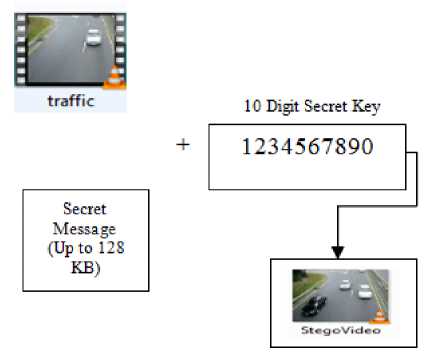
Fig.2. Embedding Process of Proposed Work
Now, hide encrypted secret message using 4 LSB and 7 pairs identical match method in edge pixels and nonedge pixels respectively and generate Stego video file [17]. Repeat the previous process for selecting next format based video i.e. Mp4, WMV or .AVI video and hide same secret message using same algorithm steps for embedding data behind video file. In the last step, analyze the effect of quality of different format based video files on the basis of PSNR, BER, and histogram Analysis and analyze effect of quality after hiding information in different format video files and apply Chi-Square Attack on Stego Video to analyze Chi Index value which should not exceed its critical value i.e. 0.05.
-
B. Extraction Algorithm
The extraction process is a reverse process of embedding algorithm used to extract hidden information from media file and it is carried out at the receiver side. The extraction process includes various steps. In the first step, Select Stego video and enter same 10 digits secret key at the receiver side to extract hidden data and extract the secret key, selected frame addresses and length of a message from the 1st frame of Stego video. Also, extract secret message by using the reverse process of embedding algorithm i.e. reverse of 4LSB substitution and using bit positions of 7 pair identical match techniques [3]. At the end, decrypt extracted message using the reverse of XOR encryption algorithm and display output as hidden secret text message.
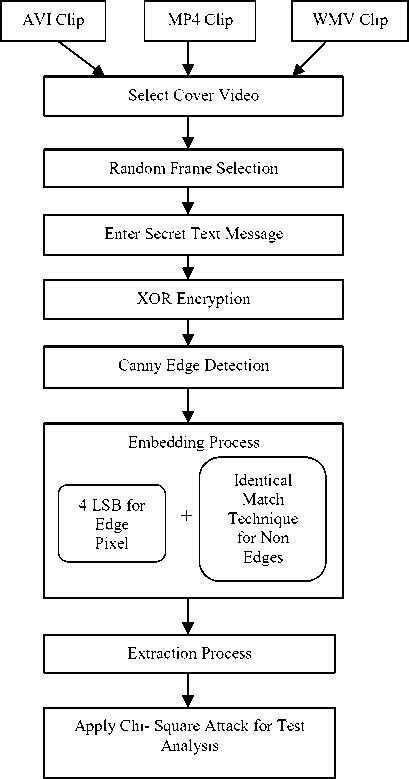
Fig.3. Flow Chart of Proposed Work
-
V. Experimental Results
The proposed algorithm simulation is done on MATLAB 7.0 version 2014a. The experimental results show that our algorithm is good enough to support different type of video formats such as AVI, MPEG, and MP4. It also shows that AVI video base steganography has high quality as compared to MPEG Video clip. But MP4 format video generates high-quality stego video during steganography process and it has high security and no loss of data after hiding information due to lossless compression mode.
-
A. Extraction Results
The experimental results are analyzed on the basis of PSNR (Peak signal to Noise Ratio), BER (Bit Error Rate), MSE (Mean Square Error) and Payload Capacity for a different type of video formats such as AVI, MP4, and WMV. The test analysis is conducted using different video formats such as AVI video named as ‘Traffic.avi’, MP4 named as ‘MyKrishna.mp4’ & WMV video named as ‘Clip_1080_5sec_VC1_15mbps’.
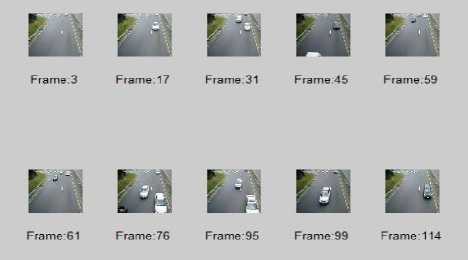
Fig.4. All Original Random Frames
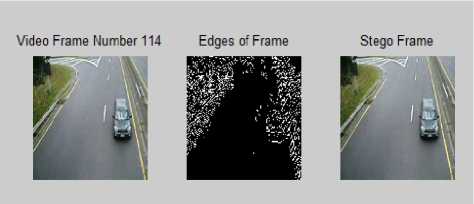
Fig.5. Edge and Stego Frames
Table 1. Test I for AVI Video Format
|
Video Clip Format |
Data Capacity (KB) |
PSNR (db) |
MSE |
|
Traffic.avi |
4 KB |
66.14 |
0.01511 |
|
64 KB |
54.40 |
0.01838 |
contains secret message behind all random frames.
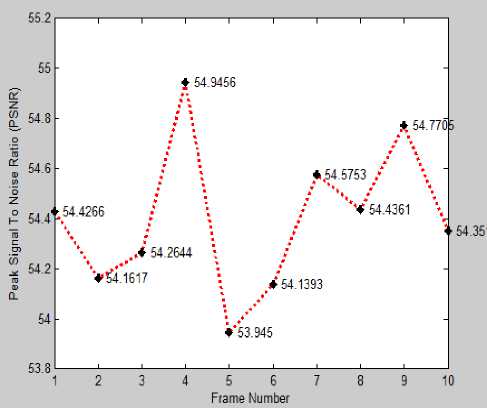
Fig.6. PSNR of all Random Frames (64 KB)
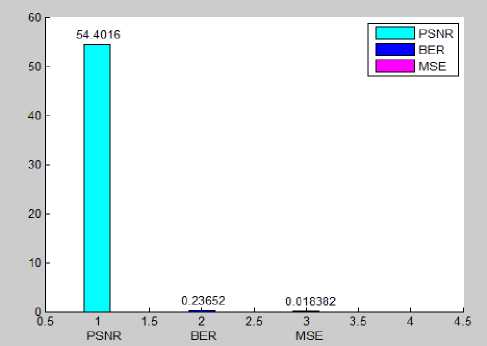
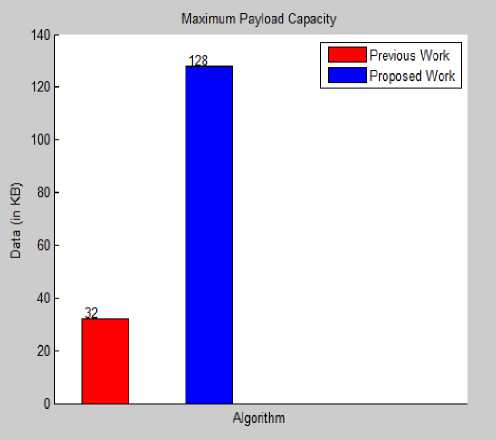
Fig.8. Maximum Data Hiding Capacity

Fig.9. Showing MP4 Video’s Original Random Frames
Table 3. Testing Results for WMV Video Format
|
Video Clip Format |
Data Capacity (KB) |
PSNR (db) |
MSE |
|
‘Clip_1080_5se c_ VC1_15mbps. wmv |
4 KB |
65.4004 |
0.0189 |
|
64 KB |
53.2451 |
0.3107 |
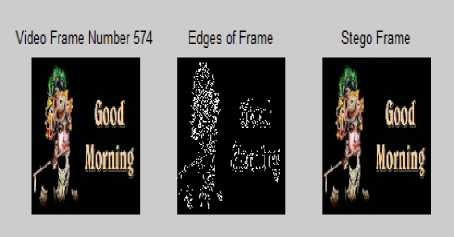
The quality analysis is done on the basis of PSNR quality metrics for a different type of video formats. A video file can be of any type of video format such as AVI, Mp4, and Flv etc. But, in this work we are analyzing quality effect using Mp4, Avi, and WMV video formats and conclude that this algorithm supports different type of video formats. The present work is also an integrated approach of cryptography based steganography technique and provides 3-Tier security level using edge detection algorithms and Fig.13 is highlighting the main fundamentals and difference between data security techniques such as encryption techniques like cryptography, data hiding technique like digital steganography and copyright protection techniques like watermarking. It resists the risk of frame dropping and data manipulation problems as same data is hidden in all random frames and in case, due to some failure or attack some frames get damaged, then we can still recover secret message from another random frame.
Table 2. Testing Results for MP4 Video Format
|
Video Clip Format |
Data Capacity (KB) |
PSNR (db) |
MSE |
|
MyKrishna. mp4 |
4 KB |
65.78 |
0.015202 |
|
64 KB |
53.5787 |
0.2871 |
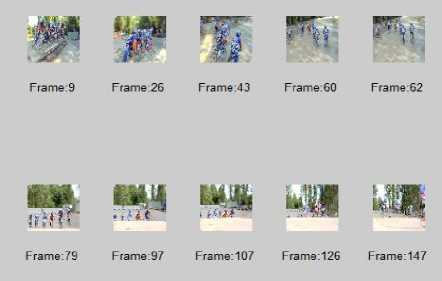
Fig.11. Showing WMV Video’s Original Random Frames
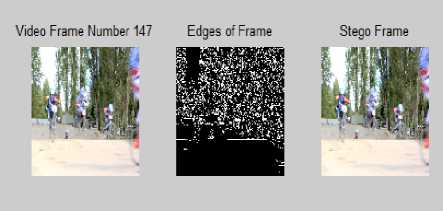
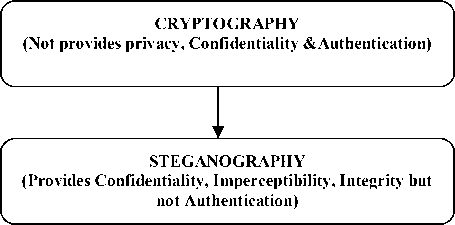
WATERMARKING
Additional Characteristics of steganography
Fig.13. Three-Tier Security Approach
-
B. Video Steganalysis Testing
The steganalysis testing is done using visual and statistical attacks on the basis of histogram analysis and chi-square attack and find out that this algorithm is able to resist such type of attacks. Chi-square attack is a statistical attack which performs for detecting hidden data embedded by LSB based substitution techniques [20]. The test is conducted on a video file named as ‘Traffic.avi’ having 114 total number of frames used for hiding 4 KB data behind each 10 random frames of a video clip using 10 digits secret key i.e. ‘1234567890’. The experimental results of the test show that the data
hidden by proposed algorithm is undetectable when attackers will apply attack by chi-square steganalysis. The chi-square attack is analyzed by using chi-index value as shown in Fig.14, which is showing the Chiindex values for 10 random frames & Fig.15, which is showing the average results for Comparison of Chi-index values for different methodologies such as LSB, 4LSB and proposed work i.e. Edge-4LSB . The chi-square index’s average value for basic LSB technique is analyzed larger than 0.5 and in 4LSB based substitution average index value is around 0.1443. But, in proposed algorithm its average value is near to 0.0107.
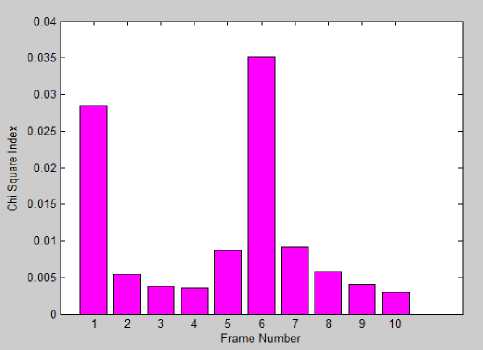
Fig.14. Chi Square Steganalysis (4 KB)
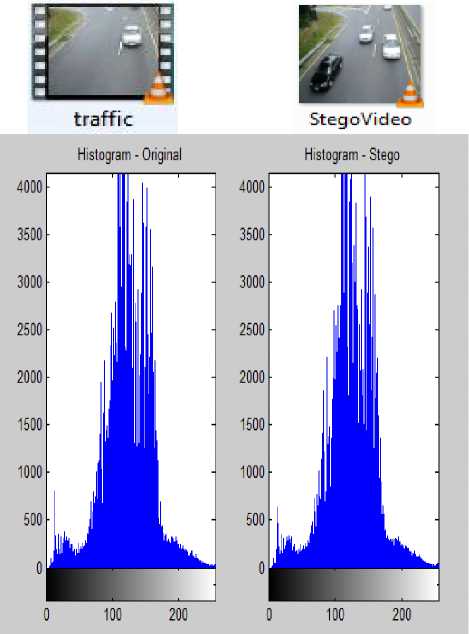
Fig.16. Histogram Analysis For Original and Stego Video
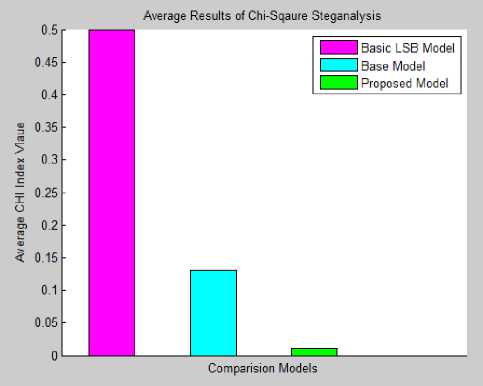
Fig.15. Comparison of Average Results for Chi-index
-
VI. Conclusion and Future Scope
Acknowledgment
We wish to thank parents, teachers, supervisors and friends for their great support and help during the making of this research paper. We also thank all researchers whose previous work gives us a way to extend and complete research work.
Appendix A Abbreviations
|
AVI |
Audio and Video Interleaved |
|
MPEG |
Motion Picture Expert Group |
|
MP4 |
MPEG Type-4 |
|
WMV |
Window Media Video Format |
|
MP4 |
MPEG Layer 4 Type Format |
|
FLV |
Flash Video Format |
|
XOR |
Exclusive OR i.e. Boolean Expression |
|
LSB |
Least significant Bits |
|
PSNR |
Peak Signal to Noise Ratio |
|
BER |
Bit Error Rate |
Список литературы XOR-EDGE based Video Steganography and Testing against Chi-Square Steganalysis
- Ramandeep Kaur, Pooja, and Varsha, "The NonTangible Masking of Confidential Information using Video Steganography", International Journal of Computer Applications (IJCA), Vol.119, No.17, June 2015.
- Ramandeep Kaur, Pooja, "XOR Encryption Based Video Steganography", International Journal of Science and Research (IJSR), Vol.4, Issue 11, November 2015.
- Sunil. K. Moon, Rajeshree. D. Raut (2013), "Analysis of Secured Video Steganography Using Computer Forensics Technique for Enhance Data Security", IEEE Second International Conference on image information processing (ICIIP- 2013), pg 660-665.
- Pooja Yadav, Nishchol Mishra, and Sanjeev Sharma (2013)," A Secure Video Steganography with Encryption Based on LSB Technique", IEEE International Conference on Computational Intelligence and Computing Research.
- Geetha C.R., H. D. Giriprakash (2012), "Image Steganography by Variable Embedding and Multiple Edge Detection using Canny Operator", International Journal of Computer Applications (0975 – 888) ,Volume 48, No.16, June.
- Sarabjeet Kaur and Sonika Jindal (2013), "Image Steganography using Hybrid Edge Detection and First Component Alteration Technique", International Journal of Hybrid Information Technology Vol.6, No.5, pp.59-66.
- Amrinder Singh, Sukhjit Singh (2014), "A Robust Video Watermark Embedding and Extraction Technique Based on Random Frame Selection", IJRIT International Journal of Research in Information Technology, Volume 2, Issue 2, February, pp: 28-37.
- Soumyajit Sarkar, Arijit Basu (2014), "Comparison of various Edge Detection Techniques for maximum data hiding using LSB Algorithm", International Journal of Computer Science and Information Technologies, Vol. 5 (3).
- Shivani Khosla, Paramjeet Kaur (2014), "Secure Data Hiding Technique Using Video Steganography and Watermarking", International Journal of Computer Applications, Volume 95, No.20, June.
- Mamta Juneja and Parvinder Singh Sandhu (2014), "Improved LSB based Steganography Techniques for Color Images in Spatial Domain", International Journal of Network Security, Vol.16, No.6, pp.452-462, Nov.
- Mamta Juneja, Parvinder Singh Sandhu, "A New Approach for Information Hiding in Color Images using Adaptive Steganography and Hybrid Feature Detection with Improved PSNR and Capacity", International Journal of Engineering and Technology (IJET), Vol. 5, No. 2, Apr-May 2013.
- Youssef Bassil (2012), "Image Steganography based on a Parameterized Canny Edge Detection Algorithm", International Journal of Computer Applications, Volume 60– No.4, December.
- Arijit Basu, Gaurav Kumar, Soumyajit Sarkar (2014), "A Video Steganography Approach using Random Least Significant Bit Algorithm", International Journal of Science and Research (IJSR), Volume 3 Issue 6, June.
- A.Swathi, Dr.S.A.K Jilani (2012), "Video-Steganography by LSB Substitution Using Different Polynomial Equations", International Journal Of Computational Engineering Research, Vol. 2, Issue. 5, September.
- Vijay Kumar Sharma, Vishal Shrivastava (2012), "A steganography algorithm for hiding the image in image improved LSB substitution by minimizing Detection", Journal of Theoretical and Applied Information Technology, Vol. 36 No.1, February.
- Wen-Jan Chen, Chin-Chen Chang , T. Hoang Ngan Le (2010) , "High payload steganography mechanism using hybrid edge detector", Expert Systems with Applications, Elsevier (37).
- Atallah M. Al-Shatnawi (2012), "A New Method in Image Steganography with Improved Image Quality", Applied Mathematical Sciences, Vol. 6, no. 79, pp .3907 – 3915.
- Krishna Nand Chaturvedi, Amit Doeger (2014), "A Novel Approach for Data Hiding using LSB on Edges of a Gray Scale Cover Images", Volume 86 – No 7, January.
- K.V.Vinodkumar, V. Lokeswara Reddy (2013), "A Novel Data Embedding Technique for Hiding Text in Video File using Steganography", International Journal of Computer Applications, Vol. 77, No.17, September 2013.
- Yeuan-Kuen Lee, Graeme Bell, Shih-Yu Huang, Ran-Zan Wang, and Shyong-Jian Shyu, "An Advanced Least-Significant-Bit Embedding Scheme for Steganographic Encoding", Springer, 2009, pp-349-360.
- Poonam Dhankhar, Neha Sahu, "A Review and Research of Edge Detection Techniques for Image segmentation", International Journal of Computer Science and Mobile Computing, Vol. 2, Issue 7, July 2013, pp. 86-92.
- Dr.S.Vijayarani, Mrs. M. Vinupriya, "Performance Analysis of canny and Sobel Edge Detection Algorithm in Image Mining", International journal of Innovative Research in Computer and Communication Engineering, Vol.1, Issue 8, October 2013.
- http://Stegnao.net/tutorial/steh-history.html- accessed on 12 March 2016.
- K. Naveen BrahmaTeja, Dr.G. L. Madhumati, K. Rama Koteswara Rao, "Data Hiding using EDGE based steganography", International journal of Emerging Technology and advanced Engineering, Vol.2, Issue 11, November 2012.
- Parveen.P, Arun.R, "Audio-video Crypto Steganography using LSB substitution and advanced chaotic algorithm", International Journal of Engineering Inventions, Vol. 4, Issue 2, August 2014, pp. 01-07.
- Ramandeep Kaur, Pooja, Varsha, "A Hybrid Approach for Video Steganography using Edge Detection and Identical Match Techniques", IEEE WISPNET 2016 conference, March 2016.

